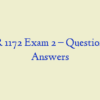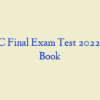Description
MIS 564 Final Exam Practice 1 – Week 7
Final Exam Practice
- (CO A) A reference repository that holds metadata about all the databases, their component parts, the data in the databases, and the security details.
- (CO A) Responsible for data strategy, information architecture, and establishing the policies and procedures used by an entire organization for its data use and management.
- (CO A) Responsible for the development and day-to-day administration and maintenance of a database.
- (CO A) Responsible for the efficiency and optimization, access rights, and monitoring of a specific database, as well as participating in the DDLC for new databases.
- (CO A) An organization where the DA reports to a project manager and a data administration manager.
- (CO A) Between a DA and a DBA, excellent communication skills are critical for which position?
- (CO A) The DDLC is what and composed of what states?
- (CO D) A query language used to locate and retrieve nodes in an XML document:
- (CO D) XSL is comprised of what three parts?
- (CO D) An XML based web feed used to publish dynamic material
- (CO D) A database management system optimized to store, retrieve, and update XML documents natively:
- (CO D) A language used to describe another language
- (CO D) Embeds information about the data it holds in a hierarchical format which is self describing.
- (CO D) A closed markup language used to render data on a web browser.
- (CO D) Embeds XML file that associates a namespace with an XML document and describes the legal format, structure, content, and semantics of the document.
- (CO F) Techniques and technologies used to exploit large data stores in order to support decision making
- (CO F) OLAP
- (CO F) The two approaches that are used to exploit a datastore
- (CO F) A RDBMS where the multidimensional model is imposed on a relational model.
- (CO F) Name two ROLAP schemas.
- (CO F) The five data mining functions include:
- (CO F) An exchange of information, or conversation, between two applications is called
- (CO F) A computer host or small network inserted as a “neutral zone” between a company’s private network and the outside public network.
- (CO F) A small data item stored on the user’s computer by a web browser used for session tracking, authentication, storing site preferences, etc.
- (CO F) An application that manages the content of a website, including concurrent updates, imposing format consistency, and content versioning.
- (CO F) A web application is an example of what kind of architecture?
- (CO F) Name at least 3 web browser-to-DBMS server connectivity tools.
- (CO A) Domain
- (CO A) Primary Key
- (CO A) List the Relational Algebra Operators
- (CO A) A Join is
- (CO A) The SQL Constraints are
- (CO A) A View
- (CO A) NULL
- (CO A) What are the SQL Security Commands?
- (CO B) File servers, DBMS servers, 2-tiered, and 3-tiered are examples of
- (CO B) Super computers are used in which architecture?
- (CO B) A Distributed Database
- (CO B) Distributed Database Fragmentation techniques
- (CO B) Replication database
- (CO D) What is a TPS?
- (CO D) What are the desirable corporate data attributes? (Sharable, transportable, secure, accurate, timely, and relevant)
- (CO D) An Attribute
- (CO D) An Entity
- (CO D) Four building blocks of a data model:
- (CO D) Data Modeling
- (CO D) Describe the cardinality relationships.
- (CO D) A Generalization
- (CO D) Functional Dependency.
- (CO D) A relation is in 2-NF if,
- (CO D) A relation is in 3-NF if,
- (CO D) Goals of Normalization
- (CO E) The transaction manager
- (CO E) Used to solve concurrency issues
- (CO E) When 2 users lock resources needed by each other so neither can progress it is called
- (CO E) The 4 primary attributes a DBMS Transaction Manager enforces for any transaction
- (CO E) When an outcome is determined by the sequence or timing of events instead of deterministic processing, it is called a
- (CO E) A recovery procedure which backs out unwanted change in a database is called
- (CO E) A recovery procedure which uses a prior saved database state and applies after image records from update transactions
- (CO E) Verifying a user is who they say they are is
- (CO E) Authorization is
- (CO G) What managers are involved in database access?
- (CO G) An attribute used to narrow down the search space when accessing a row with a specific value for the attribute.
- (CO G) When we access the disk, we are accessing what kind of memory?
- (CO G) An index structure that is efficient for both sequential and direct file access is
- (CO G) A standard format used to represent written text in many different languages
- (CO G) A redundant array of independent disks
- (CO G) Which RAID levels are not good for applications with heavy update requirements?
- (CO G) What technique uses a function to convert a field into an address to promote direct accessing?





